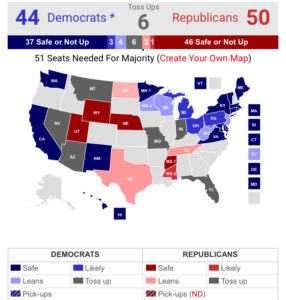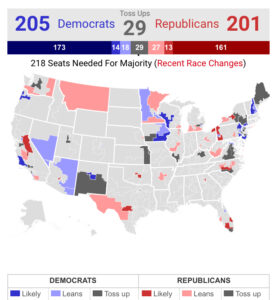2018 Midterms Down to the Wire
With so much on the line, there is considerable excitement about the 2018 midterms. On November 6th, voters will go to the polls to determine who controls the two houses of Congress and thus, what policies and laws will be possible for the next two years. The Democrats are hopeful that they can win control of the House of Representatives which could block efforts by the Trump administration to lower taxes; reform healthcare; and achieve immigration reform, including greater border security. Given the actions of the Democrats of late, it is possible a Democrat majority in the House could stifle all legislation and refuse to cooperate with the Senate and administration at all. It is hard to imagine that, after the very personal and hateful attacks against Judge Kavanaugh for example, there will be much bipartisanship or cooperation from that quarter. As conservative commentator Rush Limbaugh recently noted: “In a just world the voters would punish the Democrats with electoral defeat.” (Featured image courtesy The Telegraph UK).
Historical Trends
Many people are chiming in about historical trends going against the President in the first midterm election. This has been true in some cases, but in general, the majority of the House of Representatives has gone unchanged in the first midterm of most Presidents. In 2010 and 1994, for sure, there were wild swings away from the President’s party. Let us not forget that these elections were in situations wherein a Democrat President was in office and where that president was advocating for policies, especially in the realm of healthcare, to which many Americans objected. Essentially, the house majority changes when you have a leftwing president who strikes out too far to the left. In 2002 during President Bush’s first midterm, the House majority went unchanged. This was the case in 1990 as well, although the first President Bush did not do himself any favors. In midterm elections during a president’s first term in 1982, 1978, 1970, and 1962 there was no change in the majority of the House of Representatives. There is no certainty of historical trends in politics, even less so given an honest evaluation of the evidence.
There are also several factors that indicate against the Democrats in this election cycle. First, GOP voters have been turning out in greater numbers, defeating the registration advantages that the Democrats appear to have on paper. In Florida, for example, nearly a quarter million more Republicans turned out for the primary than Democrats. This trend has been similar in many key battleground states where GOP turnout has been higher than or nearly equal to Democrat turnout in primaries. Second, there is the Kavanaugh effect. The recent false allegations raised against the President’s Supreme Court appointee and the protests and angry mobs that surrounded it, have driven many undecided voters over to the GOP column. Finally, the usual markers for midterm swings are not present: the economy is booming, the President’s approval is around 50%, and there is no mood of general dissatisfaction with the direction of the country. The outrage and anger are those of the far left. Loud though they are, they do not reflect the feelings of most Americans. If the economy were stagnant or down, if the mood of the country was general dissatisfaction, the GOP might suffer significant losses.
The Senate Races in 2018
In the 2016 election the GOP lost two seats in the US Senate to hold a narrow 52-48 majority (two independent Senators caucus with the Democrats). The loss of one seat in Alabama last year after the GOP candidate was accused of sexual misconduct narrowed the majority even further to 51. With this class of Senators the GOP is defending just 9 seats while the Democrats are defending 26 (including the aforementioned independents). Only three GOP seats are remotely in jeopardy. In Tennessee polls are looking good for Blackburn to succeed Corker and hold the seat for the GOP. In Arizona McSally is doing quite well against her opponent, although polls are tighter. In Nevada incumbent Dean Heller is struggling to hold onto his seat in a state that went narrowly to Clinton in the last presidential election. Meanwhile, in five states the Democrats are defending a senator in states that voted for President Trump by double-digits: Indiana, Missouri, Montana, North Dakota, and West Virginia. The Democrats are also defending six seats in states Trump carried more narrowly: Florida, Ohio, Pennsylvania, Michigan, and two in Wisconsin.

Given the recent Kavanaugh hearings, many of these Democrat incumbents are not looking good. In North Dakota, Heitkamp has been trailing by wide numbers throughout the race. In Indiana, Florida, Missouri, and Montana, the races are too close to call, offering the GOP opportunities for gains. In West Virginia, Joe Manchin, a known moderate, who voted for Kavanaugh’s nomination, has seen a sudden drop in support and his race may be more competitive than previously thought. The GOP should be able to defend its three current seats and gain five or six more. There is very little likelihood that the Democrats will successfully defend all of their seats and gain the two seats necessary to take control of the Senate. 538 and CNN are even giving up on the Senate at the same time that they predict a Democrat win in the House of Representatives.
The House in 2018
In the current polls, according to Real Clear Politics (RCP), the House is in significant jeopardy of going to the Democrats. According to RCP, the Democrats are already favored to win in 13 GOP seats. The Republicans are, themselves, likely to pick up three Democrat seats. That puts the Democrats up about ten seats in current polling. Some 29 seats are too close to call. The Democrats would have to win 13 of out of 29 to gain a majority. The GOP would need to defend 17 to hold the majority. Let us not forget that these polls historically lean to the left, they do not account for higher GOP voter turnout indicated by primary turnout trends, and they are only recently seeing the effects of the Kavanaugh hearings; the full effects of which will not truly be known until the polls close on election night. Under the circumstances there is significant cause for alarm on the right, but the situation is far from hopeless. It is likely the Democrats will gain seats in the House this election cycle, they are already up 10 in the current polling, but even if they were to gain 10 more they would still fall short of a majority.

It is up to the Voters
This news should serve as a call to arms for GOP voters and Trump supporters to turn out in greater numbers in November. The right cannot afford to forgo even a single vote. Those who wish to see decency and civility in politics must also turnout to punish the Democrats for their false accusations, disgusting protests, and mob mentality. American voters must come out to restore sanity and reason to Congress.







